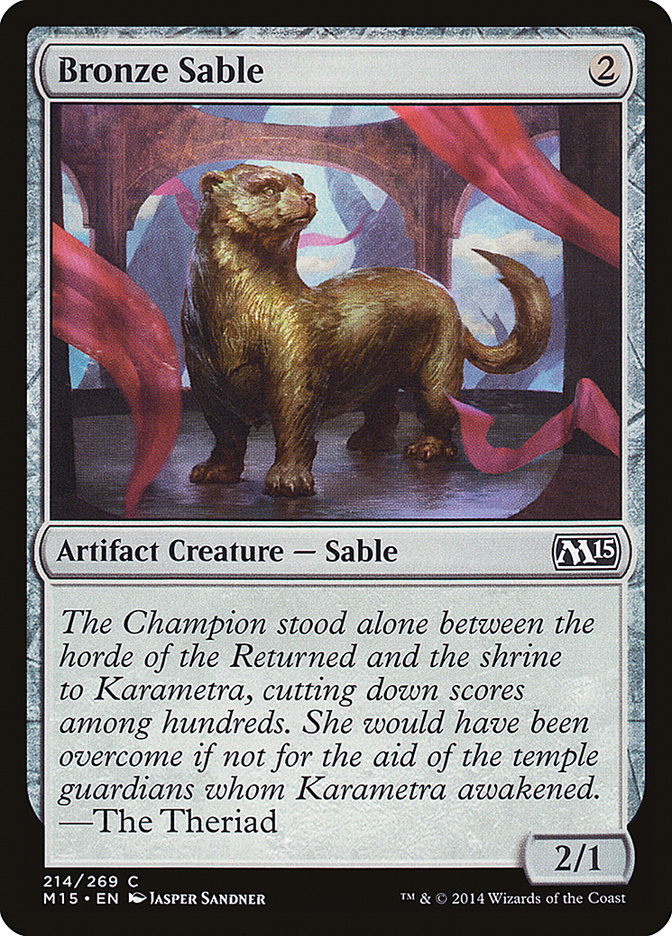Last week, I shared my experience at the 2015 Super Sunday
Series Championship. It was a pretty amazing experience.
One of my favorite things that happened at the event though, was an ongoing conversation with Michael Bonde about Death and Taxes.
After the event, Marijn Lybaert would joke about it, amused that he and I could spend “two hours arguing over White Weenie,” but I’m pretty sure that
neither Michael and I viewed our long conversation as an argument. For me, Bonde is one of the experts of the archetype, and Death and Taxes is one of the
four decks that I tend to play in Legacy. I knew I might have some differing opinions, but I think it is always important to do what you can to be ready to
learn.
I think that when you share the same interest in a deck, if you can have a real conversation about it, it is a naturally bonding experience. On Friday
night, when I joined the gathering of competitors hanging out playing cards, most people were drafting. I was hunting for a Legacy game. Bonde, hearing me
asking for an opponent, immediately expressed his disappointment that he hadn’t brought his deck, and then we got to talking about what we like in Legacy.
“Mono-White Control,” Bonde said. “That’s what we keep trying to get people to call ‘Death and Taxes,’ but I think the name will never change now. It’s
stuck.”
I’ve long advocated the idea that Death
and Taxes is not White Weenie. White Weenie is an aggro deck. Its gameplan hinges upon killing the opponent quickly. Death and Taxes, by
contrast, is much more like a jiu jitsu master, who is more likely to end a fight slowly getting into position and then finding a hold where they just
choke their opponent out. If you’d like to read more about what makes Death and Taxes tick, I very much recommend my own article on the subject.
While Thomas Enevoldsen is, for many, the most well-known figure piloting Death and Taxes, Michael Bonde is not far behind him. The coverage of their Death and Taxes mirror
match only barely scratches the surface in showcasing just how harrying the mirror match can be. For reference, here are their lists, both in the
Top 8 of GP Strasbourg, back in 2013:
Creatures (27)
- 4 Mother of Runes
- 2 Mangara of Corondor
- 2 Aven Mindcensor
- 3 Flickerwisp
- 4 Stoneforge Mystic
- 3 Mirran Crusader
- 4 Phyrexian Revoker
- 1 Fiend Hunter
- 4 Thalia, Guardian of Thraben
Lands (23)
Spells (10)

Creatures (27)
- 4 Mother of Runes
- 2 Mangara of Corondor
- 2 Aven Mindcensor
- 3 Flickerwisp
- 4 Stoneforge Mystic
- 3 Mirran Crusader
- 4 Phyrexian Revoker
- 1 Fiend Hunter
- 4 Thalia, Guardian of Thraben
Lands (23)
Spells (10)

Attentive readers will notice that these decks are practically identical, with Enevoldsen running a Sunlance and a Leonin Relic-Warder instead of Bonde’s
extra Relic of Progenitus and Oblivion Ring. These two would meet in the Top 4, with Enevoldsen defeating Bonde on his way to winning the event. It’s also worth noting that these decks predate True-Name Nemesis.
Ah, True-Name Nemesis. Once this card was printed, it fundamentally changed what Death and Taxes had to fear. If the card worked ever-so-slightly
differently, it could be managed. “Protection from the chosen player” doesn’t leave much wiggle room, however.
In response, Serra Avenger became one of the default go-tos for the new versions of Death and Taxes. The idea was that you’d be able to go to the air and
simply kill the opponent before the True-Name Nemesis would kill you, and you would otherwise just work on containing their Umezawa’s Jitte and potentially
use your few True-Name Nemesis answers in conjunction with Serra Avenger to end the game. Additionally, a Serra Avenger could block and kill an Insectile
Aberration, so it served as an “answer” keeping in the character of the deck.
I just don’t buy it.
I’ve even lost to Serra Avenger with True-Name Nemesis in play, and I still don’t buy it.
I wrote about this in my article ‘Death & Taxes vs.
True-Name Nemesis’. Since then, I’ve done more testing, and I continue to feel like Serra Avenger is not the answer. In that article, I related
Brian Kibler’s and Craig Wescoe’s experiences playing Serra Avenger, and it continues to ring true today:
“Kibler was particularly emphatic about the failure of Serra Avenger to turn games around that involved a True-Name Nemesis, whereas Craig largely
dodged
[TNN…] Half of [Kibler’s] losses came from True-Name Nemesis, and the “to the air” plan did practically nothing to change this.”
In Seattle, Bonde and my discussion on this point was probably the closest we got to strong disagreement; Bonde seemed to acknowledge my point that it
wasn’t a true solution, but he also argued that the card still had enough utility to be worthwhile, and you could pick up some percentage of games against
True-Name Nemesis based on Serra Avenger. My feeling was that it wasn’t a very large percentage, and you lose value against basically every other
opponent you end up playing who isn’t running Delver of Secrets.
Answering Delver of Secrets, I felt, could be just as easily handled by running a large number of fliers in general. Bonde agreed that he loved Flickerwisp
but wasn’t such a huge fan of Aven Mindcensor. I chuckled, and showed him my list, packing the full set of Flickerwisp but only running a single Aven
Mindcensor.
We went back and forth on basically every card in the deck. Ultimately, there were some things we never saw eye-to-eye on, but he definitely made me change
my thinking about several cards.
Here is my version of the deck after our incredible series of conversations over last weekend:
Creatures (26)
- 4 Mother of Runes
- 2 Mangara of Corondor
- 1 Aven Mindcensor
- 4 Flickerwisp
- 4 Stoneforge Mystic
- 2 Mirran Crusader
- 3 Phyrexian Revoker
- 4 Thalia, Guardian of Thraben
- 1 Brimaz, King of Oreskos
- 1 Containment Priest
Lands (23)
Spells (11)

There is a lot about my list that can probably be called fairly ‘stock,’ and a small amount that isn’t. Let’s talk about the details of both sides of that
question.
3 Karakas
9 Plains
These cards are all a fairly unsurprising part of the list. For the most part, most people agree that these are all the cards you need to be running. There
is occasionally some debate on Flickerwisp and Sword of Fire and Ice, but I can settle some of that now: Flickerwisp is, at least, a three-of, and if
you’re a Mangara list, as I am, there is no excuse for running less than four. Sword of Fire and Ice entered into the list largely in response to True-Name
Nemesis, and it has enough utility even in other matchups that it still seems very worthy of including.
Now, onto other elements of the deck that are slightly different.
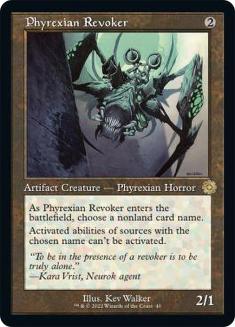


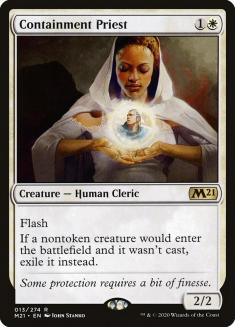

This was the final change that I implemented to the list. Bonde and I talked a long time about every card, but one of the things that he said that really
got me thinking was that there were simply a lot of Delver decks right now, and in those matchups, Phyrexian Revoker was basically this:
I expect to go back to four Phyrexian Revoker when the metagame shifts, but for now, the “fourth” Revoker is Containment Priest, which is certainly a very
different card but can hate out a number of different decks (including the mirror).
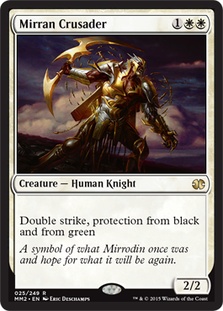

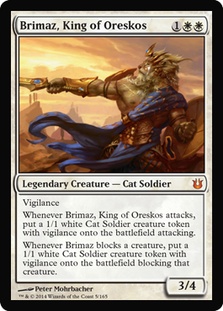

My heavy hitters, these are the cards I use to finish out the game. With Sultai Delver seemingly on the uptick, Mirran Crusader feels very powerful, and
even against other decks, it hits very hard and completely answers a Tarmogoyf. Brimaz, King of Oreskos is slightly there as another card that is solid
against True-Name Nemesis but is also resilient to Lightning Bolt.
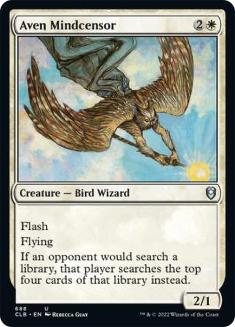

The first Aven Mindcensor is also the “fifth” Flickerwisp when it comes to fighting in the air. Beyond that though, the diminishing returns on Aven
Mindcensor are a real thing, but you don’t have to worry about that factor with only one copy. In addition, even showing the card once in a game can affect
the rest of the match, as an opponent can second-guess what they need to do for fear of Mindcensor.
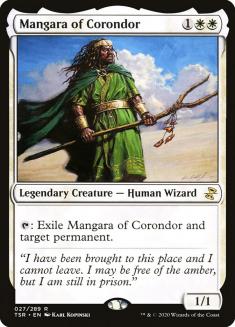


In my opinion, Legacy games can tend to go long. Mangara of Corondor is excellent when you’re fighting for a long game. Mangara of Corondor/Karakas can
feel like a one-trick-pony “cute joke” kind of play, but it’s actually a very devastating thing to have access to. I used to have only one Mangara, but
recently I’ve come to the conclusion that now is the time for this strategy.
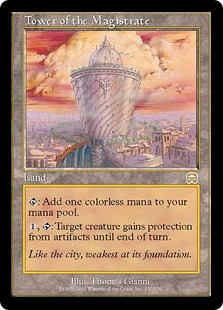

There are a lot of Stoneforge Mystic where I’ve been playing; Tower of the Magistrate is an unfair card in those matchups. Still, sometimes I wonder if I’m
pushing my color needs too much with this card, and I might change it back to a Plains.
The sideboard is worth going into card-by-card as well.
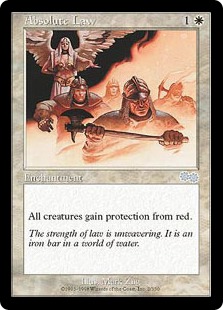

Lightning Bolt and Pyroclasm are the big targets for this card. In many cases, there are decks whose entire plan involves using burn as a control
mechanism. This shuts that plan down entirely.
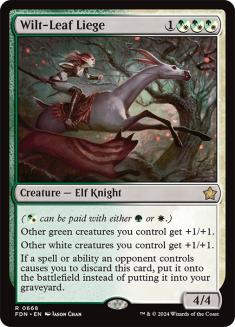

Wilt-Leaf Liege is, in part, an anti-countermeasures card. The Liege can take some of your creatures out of Pyroclasm range, keep everyone alive through
Dread of Night, and be a surprise against a Liliana of the Veil. This is my most likely candidate for card-to-cut in the board, though I have had as many
of three of this card in the board at different points in the past.
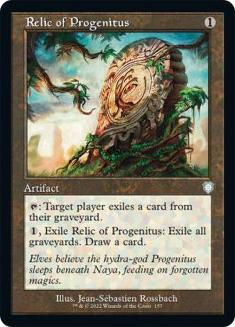



The graveyard matters. Tarmogoyf and Deathrite Shaman (not to mention Tasigur, the Banana Eater) don’t like Rest in Peace one bit. However, I’m firmly in
the Danish camp of having one Rest in Peace replaced by a Relic of Progenitus, both to dodge Cabal Therapy from Dredge, but also just to make it less
likely that you’ll end up drawing “too many” graveyard answers.
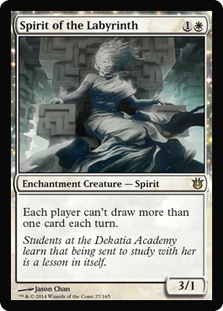
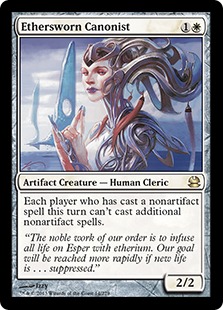


Generally speaking, I don’t like Spirit of the Labyrinth, but I don’t mind it as a “third” Ethersworn Canonist against some of the combo decks. Many of
your hardest matchups really boil down to hoping they don’t kill you immediately (one of the reasons that Belcher is such a nightmare), and the
alternatives, like Mindbreak Trap, are a bit overly narrow. There is more than a little argument for Pithing Needle, but the narrow case where that card
can save you has me leaning towards more versatile solutions like these creatures.
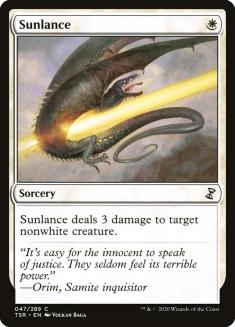

When you absolutely must kill a creature on turn 1 or 2, this is the card. You might otherwise see Dismember or Gut Shot in this place, but life loss does
matter; you don’t see Path to Exile because you really, really don’t want to give an opponent more mana with this deck.
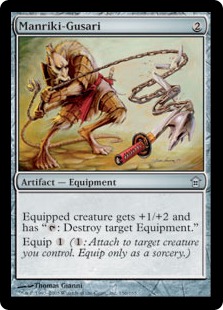

Purely there to fight the Stoneforge Mystic battle, sometimes I replace this with Ratchet Bomb. This card is also important as a part of the plan of “keep
the Jitte off of the Merfolk.”
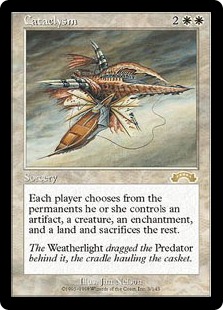


I probably have played this card less than 5% of the times that I’ve played Death and Taxes. Michael Bonde really sold me on this card in Seattle though.
What it boils down to is that some matches can really come down to starting the game over and hoping for the best. If you don’t get on top of Miracles and
they haven’t stumbled, they really have the tools to pick you apart. Cataclysm gives you a hope for those games where you’re suffering under that
situation. In addition, decks like Lands have to work very hard to recover from this card, and plenty of other decks are similarly crippled by Cataclysm.
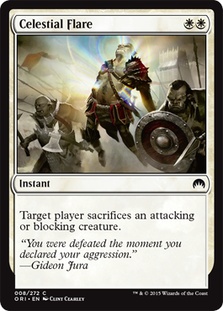
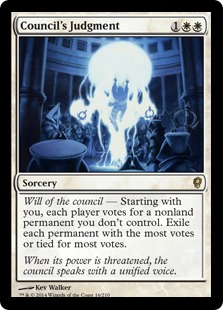
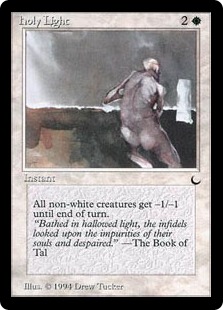

The true True-Name Nemesis hate package, I run a split of cards because they are all useful against different decks as well. Each of these cards can answer
a True-Name Nemesis (or all of them, in the case of Holy Light), but they also have other applications. Celestial Flare can be useful against
True-Name Nemesis decks even when they don’t have out the Merfolk, but it also is a weapon against Sneak and Show or any deck which is liable to
be in combat with a single huge creature. Council’s Judgment is a catch-all against any permanent that is causing problems. Holy Light can wipe the board
of goblin tokens or pesky elf decks.
Of course, perhaps you’d prefer going with the list played by Thomas Enevoldsen this last weekend in Indianapolis. I still can’t condone Serra Avenger, but
there probably has to be some merit to them if he continues to play a few copies.
Creatures (26)
- 4 Mother of Runes
- 2 Serra Avenger
- 4 Flickerwisp
- 4 Stoneforge Mystic
- 2 Mirran Crusader
- 4 Phyrexian Revoker
- 4 Thalia, Guardian of Thraben
- 1 Brimaz, King of Oreskos
- 1 Spirit of the Labyrinth
Lands (23)
Spells (11)

Regardless of what list you prefer, I’m really happy with the positioning of Death and Taxes, but it is still an incredibly difficult deck to play
well. I feel like nearly every match I’ve lost with the deck involves a mistake of some sort. One of my most common mistakes is not naming the correct card
with Phyrexian Revoker, but other mistakes I’ve made involve making the wrong decision with Rishadan Port. At the Super Sunday Series, I was only able to
get in a single game of Legacy against a young man named Benton. Benton was playing Storm, and I led with Mother of Runes into Phyrexian Revoker (naming
Lotus Petal). I didn’t cast another spell that game, but a combination of Wasteland and Rishadan Port put on enough constraints that when Benton finally
cast As Nauseum, the loss of Lotus Petal as a mana source forced him to push deeper into his deck than he cared to, and he just barely died. I feel as
though if I hadn’t made the decision to constrain his mana the exact way I did on every single turn that I did, and if I hadn’t named Lotus Petal with
Revoker, I would have just been crushed.
As someone who enjoys the competition that Magic offers, Death and Taxes is one of my favorite decks because it interacts directly with the
opponent. All of your choices are about figuring out ways to best remove your opponent’s options. If you make the wrong call, you very well could lose (or
set up a chain of events that causes your loss). For me, this makes the games you play with Death and Taxes incredibly exciting.
I really love my current list of the deck, and I’m very grateful to Michael Bonde for lending me his expertise in our discussions last week. I know that
his own version, especially in the sideboard, is quite different than mine, but I appreciate the way that our discussion involved him looking to help me
accommodate my list for what I expected to see in the opponents I was most likely to face. When it comes to your own 75 cards for this deck, you should do
the same, and think about exactly what it is you are trying to do with each and every card choice.
I highly recommend you take my version for a spin at your next Legacy event! Let me know if Tower of the Magistrate is as good for you as it has been for
me!



